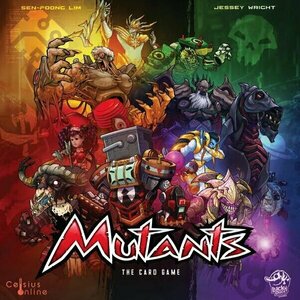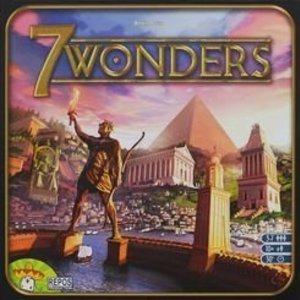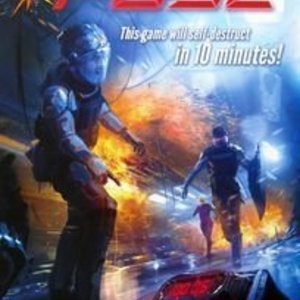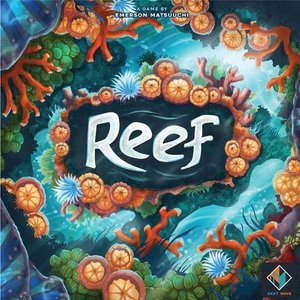Search
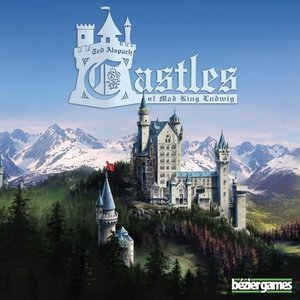
Castles of Mad King Ludwig
Tabletop Game
In the tile-laying game Castles of Mad King Ludwig, players are tasked with building an amazing,...
BoardGame
Purple Phoenix Games (2266 KP) rated Mutants in Tabletop Games
Mar 11, 2022
Boy, we have some crazy ideas when it comes to what the world will look like in the future. Flying cars? Probably. Robot house butlers? Maybe. Mutant fighters that can be formed immediately and placed into battle seconds after “birth?” Now, that’s a stretch. But, embrace the stretch here, because Mutants is all about it.
Mutants is a crazy-themed deck building, hand management, fighting, card game for one to four players. Usually in this instance I would put together a Solo Chronicles review, but I wanted to first get the multiplayer rules down and then delve into solo. In any case, this game pits players against each other in a royal rumble where controlling mutants to fight one another most effectively and efficiently will earn the player riches galore. Come check out the world of Mutants.
To setup, well, there are many steps. The biggest and perhaps most confusing step is creating the decks of mutants that will be used by players throughout the game. I will recommend you follow the rulebook for drafting your team, or simply use one of the provided pre-constructed team suggestions. Otherwise, place the main board on the table, along with the power and scoring tokens for each player. Players choose their player board according to color chosen, take their starting deck, and divide their Advanced Mutant deck into three piles, with the top card flipped face-up. Players draw a hand of six Basic Mutant cards (one of each type initially) and the battle may begin!
Mutants is played over five rounds, tracked on the main board. Each round encompasses three phases: Crush the Competition, Move Active Mutant, and Take Action. As the game progresses, the power tokens for players will be moving up and down the Power Track. If, at the start of the current player’s turn, an opponent’s power token is located in one of the last three Power Track spaces (named the Dread Zone), and the current player’s token is on the Fury Space (furthest along the Track), then the current player will score immediate bonus points by Crushing the Competition.
The first turn will not utilize the Move Active Mutant phase, but on subsequent phases, this will need to be resolved. A player’s board consists of three main slots: Left Mutant, Active Mutant, and Right Mutant. Mutants may only enter the Active Mutant slot in the middle, so if a Mutant is currently placed in that slot, it will need to be moved either to the Left or Right slot, at the player’s discretion. Should all slots be filled, one of the Mutants will need to be moved off the board to make room for the new one. Once this happens, the Mutant’s Leave Ability (at the bottom of the Mutant’s card) will activate. This could give the player more Power, some Attacking abilities, or other unique abilities. Once a card leaves their slot and applies their Leave Ability, it is placed in the Discard space at the bottom of the player board.
Now that the Active Mutant slot is available, the current player may choose from one of the Take Action choices: Deploy Mutant, Breed, or Incubate. To Deploy Mutant, simply play a card from hand to the Active Mutant slot, activating the Deploy Ability once placed. These Deploy Abilities could range from cycling (draw a card from the deck and discard a card from the hand), gaining Power, or even reactionary abilities. Breeding Mutants requires the player to discard two cards from hand whose type icons match those of one of the face-up Advanced Mutant cards atop the player board. Discarding these cards allows the Advanced Mutant to enter play on the Active Mutant slot. Finally, the player may instead choose to Incubate an Advanced Mutant from one on offer by discarding one card (and it does NOT need to match icons) and placing the chosen Advanced Mutant on the Incubator slot on the left side of the board. These incubated Advanced Mutants will be placed atop the draw deck at the end of the round, so it will be drawn during the next round.
If at any time a player needs to draw a card from their draw deck and there are no cards remaining, they will first choose a card from their Discards to Freeze, by placing it in the appropriate Cryo Freezer on the right side of the player board. Frozen cards will be scored at game end, and can really boost a final score.
At the end of the round players will perform a few more tasks and setup for the next round. First, the Power Tokens are scored according to which is in first place along the Track and so on, using the red and black VP numbers printed on the main board. The round marker is advanced one level, and each Mutant in Incubation is moved to the players’ draw decks. Players then draw a new hand of six cards, and Power Tokens are reset according to the previous round’s placement, in reverse order. The player whose Power Token is now furthest behind will be the starting player for the next round.
Play continues in this fashion of moving Mutants around, taking actions, and jockeying for supremacy along the Power Track until the end of the fifth round. At that time, the final VPs are awarded for the Power Track placement, and all cards in the Cryo Freezer are tallied. The player with the most VP at the end of the game is the winner of Mutants!
Components. Okay, I have some thoughts here, and more than just, “oh hey, they are nice.” The game comes with a bevvy of cards, some wooden tokens, and a couple “boards.” I used quotations because only the main board is an actual board. The player boards are slick cardstock and, while functional, feel a little cheap. The cards themselves are all super great and the artwork is appropriate and quite excellent. I have a couple issues with some other components, however. The Power and Score Tokens are the only wooden components in the box and I just do not understand them. They look like Sauron/Spartan helmets, or someone who is crying because they just shoved a fork into the power outlet. Now, there are four of each type in different colors, and though the colors aren’t the primary colors we have grown to accept for our player colors, they have swapped out the green for purple, and I think the game is colorful enough to include more exciting colors. So I’m not a fan of the Power and Score Tokens. Similarly, I don’t really understand the insert that comes with the game. I see that it is setup to hold TONS of cards, and maybe there were/are plans for many many expansions, but the base game can be housed in two of the 14 total card slots provided. Also, I have no idea what is going on in the middle of the insert, but I also don’t own any of the expansions yet, so hopefully those molded spots are actually meant to hold something. Everything else, though, is great!
For me, art and components are very high on my list of items that affect how much I enjoy a game. Now, I can live with the wonky Power and Score Tokens, and I suppose I don’t mind carrying around a giant box of cards, when the game could ALMOST fit inside a box the size of Bohnanza or Point Salad or the like. That said, I have definitely enjoyed my plays of Mutants. The rulebook is a little daunting at first, mostly because the theme is unique and the game style is similarly different to me. Once the game gets into the thick of it, though, strategy and tactics take over so strongly. Each card is carefully considered for its usability as either a card to be played or discarded for varying effects. I love that about this game.
This is certainly more than a “deck builder,” even though deck building and hand management are at the forefront of the mechanics here. You aren’t necessarily building your deck and cycling through it quickly enough for me to consider this a true deck builder alone, but using each card for different purposes certainly increases the replayability with Mutants. When is the best time to freeze a card versus keeping it in the deck for its abilities? Do I move off the Left Mutant or keep it around for another turn? Why did I pick these Advanced Mutants during the draft, when I have crappy supporting cards? Every play of Mutants has been a wonderful challenge of maximizing my deck and choosing just the right opponents to attack with my monstrous creations. Purple Phoenix Games gives this one a horrifically delightful 5 / 6. I hate having to bling out my games, but I think I will probably try to find replacements for the Power and Score Tokens (though maybe a little spray paint will help?), and look into grabbing one or all of the expansions so that I may be able to fill up that confusing insert. I look forward to my next games of this, and to getting the word out on this little gem I finally tried.
Mutants is a crazy-themed deck building, hand management, fighting, card game for one to four players. Usually in this instance I would put together a Solo Chronicles review, but I wanted to first get the multiplayer rules down and then delve into solo. In any case, this game pits players against each other in a royal rumble where controlling mutants to fight one another most effectively and efficiently will earn the player riches galore. Come check out the world of Mutants.
To setup, well, there are many steps. The biggest and perhaps most confusing step is creating the decks of mutants that will be used by players throughout the game. I will recommend you follow the rulebook for drafting your team, or simply use one of the provided pre-constructed team suggestions. Otherwise, place the main board on the table, along with the power and scoring tokens for each player. Players choose their player board according to color chosen, take their starting deck, and divide their Advanced Mutant deck into three piles, with the top card flipped face-up. Players draw a hand of six Basic Mutant cards (one of each type initially) and the battle may begin!
Mutants is played over five rounds, tracked on the main board. Each round encompasses three phases: Crush the Competition, Move Active Mutant, and Take Action. As the game progresses, the power tokens for players will be moving up and down the Power Track. If, at the start of the current player’s turn, an opponent’s power token is located in one of the last three Power Track spaces (named the Dread Zone), and the current player’s token is on the Fury Space (furthest along the Track), then the current player will score immediate bonus points by Crushing the Competition.
The first turn will not utilize the Move Active Mutant phase, but on subsequent phases, this will need to be resolved. A player’s board consists of three main slots: Left Mutant, Active Mutant, and Right Mutant. Mutants may only enter the Active Mutant slot in the middle, so if a Mutant is currently placed in that slot, it will need to be moved either to the Left or Right slot, at the player’s discretion. Should all slots be filled, one of the Mutants will need to be moved off the board to make room for the new one. Once this happens, the Mutant’s Leave Ability (at the bottom of the Mutant’s card) will activate. This could give the player more Power, some Attacking abilities, or other unique abilities. Once a card leaves their slot and applies their Leave Ability, it is placed in the Discard space at the bottom of the player board.
Now that the Active Mutant slot is available, the current player may choose from one of the Take Action choices: Deploy Mutant, Breed, or Incubate. To Deploy Mutant, simply play a card from hand to the Active Mutant slot, activating the Deploy Ability once placed. These Deploy Abilities could range from cycling (draw a card from the deck and discard a card from the hand), gaining Power, or even reactionary abilities. Breeding Mutants requires the player to discard two cards from hand whose type icons match those of one of the face-up Advanced Mutant cards atop the player board. Discarding these cards allows the Advanced Mutant to enter play on the Active Mutant slot. Finally, the player may instead choose to Incubate an Advanced Mutant from one on offer by discarding one card (and it does NOT need to match icons) and placing the chosen Advanced Mutant on the Incubator slot on the left side of the board. These incubated Advanced Mutants will be placed atop the draw deck at the end of the round, so it will be drawn during the next round.
If at any time a player needs to draw a card from their draw deck and there are no cards remaining, they will first choose a card from their Discards to Freeze, by placing it in the appropriate Cryo Freezer on the right side of the player board. Frozen cards will be scored at game end, and can really boost a final score.
At the end of the round players will perform a few more tasks and setup for the next round. First, the Power Tokens are scored according to which is in first place along the Track and so on, using the red and black VP numbers printed on the main board. The round marker is advanced one level, and each Mutant in Incubation is moved to the players’ draw decks. Players then draw a new hand of six cards, and Power Tokens are reset according to the previous round’s placement, in reverse order. The player whose Power Token is now furthest behind will be the starting player for the next round.
Play continues in this fashion of moving Mutants around, taking actions, and jockeying for supremacy along the Power Track until the end of the fifth round. At that time, the final VPs are awarded for the Power Track placement, and all cards in the Cryo Freezer are tallied. The player with the most VP at the end of the game is the winner of Mutants!
Components. Okay, I have some thoughts here, and more than just, “oh hey, they are nice.” The game comes with a bevvy of cards, some wooden tokens, and a couple “boards.” I used quotations because only the main board is an actual board. The player boards are slick cardstock and, while functional, feel a little cheap. The cards themselves are all super great and the artwork is appropriate and quite excellent. I have a couple issues with some other components, however. The Power and Score Tokens are the only wooden components in the box and I just do not understand them. They look like Sauron/Spartan helmets, or someone who is crying because they just shoved a fork into the power outlet. Now, there are four of each type in different colors, and though the colors aren’t the primary colors we have grown to accept for our player colors, they have swapped out the green for purple, and I think the game is colorful enough to include more exciting colors. So I’m not a fan of the Power and Score Tokens. Similarly, I don’t really understand the insert that comes with the game. I see that it is setup to hold TONS of cards, and maybe there were/are plans for many many expansions, but the base game can be housed in two of the 14 total card slots provided. Also, I have no idea what is going on in the middle of the insert, but I also don’t own any of the expansions yet, so hopefully those molded spots are actually meant to hold something. Everything else, though, is great!
For me, art and components are very high on my list of items that affect how much I enjoy a game. Now, I can live with the wonky Power and Score Tokens, and I suppose I don’t mind carrying around a giant box of cards, when the game could ALMOST fit inside a box the size of Bohnanza or Point Salad or the like. That said, I have definitely enjoyed my plays of Mutants. The rulebook is a little daunting at first, mostly because the theme is unique and the game style is similarly different to me. Once the game gets into the thick of it, though, strategy and tactics take over so strongly. Each card is carefully considered for its usability as either a card to be played or discarded for varying effects. I love that about this game.
This is certainly more than a “deck builder,” even though deck building and hand management are at the forefront of the mechanics here. You aren’t necessarily building your deck and cycling through it quickly enough for me to consider this a true deck builder alone, but using each card for different purposes certainly increases the replayability with Mutants. When is the best time to freeze a card versus keeping it in the deck for its abilities? Do I move off the Left Mutant or keep it around for another turn? Why did I pick these Advanced Mutants during the draft, when I have crappy supporting cards? Every play of Mutants has been a wonderful challenge of maximizing my deck and choosing just the right opponents to attack with my monstrous creations. Purple Phoenix Games gives this one a horrifically delightful 5 / 6. I hate having to bling out my games, but I think I will probably try to find replacements for the Power and Score Tokens (though maybe a little spray paint will help?), and look into grabbing one or all of the expansions so that I may be able to fill up that confusing insert. I look forward to my next games of this, and to getting the word out on this little gem I finally tried.
Purple Phoenix Games (2266 KP) rated 7 Wonders in Tabletop Games
Jun 12, 2019
So rarely does a game present itself that is both very difficult for highly educated people to learn the first play through, and is simultaneously easy enough to play in under 15 minutes whilst carrying on a conversation about something entirely different. Such is my love. Such is 7 Wonders.
The time has come for you to build your perfect civilization! You have plans for a glorious Wonder laid in front of you to truly emphasize your majesty. Will you be able to use your resources (and your neighbors’) wisely to construct your Wonder? Will you be able to build enough production facilities, guilds, trading facilities, temples, science, and military might to best your opponents? These are your goals as you play through 7 Wonders using a beautiful combination of card drafting, hand management, civilization building, and set collection mechanics.
DISCLAIMER: We are discussing 7 Wonders using the vanilla base game without any expansions. We have access to all expansions except the new Armada, and we will be reviewing those as well in the future, so stay tuned. -T
Okay, so like I mentioned in the intro: this game can be a bit of a bear to teach, especially if you use it as a gateway game to card drafting to newer gamers. The card drafting itself is not difficult – choose a card from the cards in your hand and then pass the rest to your neighbor. Grab the cards you received from your other neighbor and repeat the process. Drafting is easy. The hard part is deciding which of your cards will benefit you the most, and paying for the cost to build said card. I find that most players grasp the evaluating benefits and drafting, but then forget that they have to pay for the cards in order to place them on their civ. Once the payment is understood, and the combos of cards that fuel and pay for future cards, the game becomes a wonderful (eh? eh??) game of figuring out the best puzzle pieces to place in front of you.
I don’t want to explain the entire game here, so I will just tell you that 7 Wonders has been an evergreen game for me. I love it every single time it comes out, even if others in my group are less affectionate. When playing with players who get it and love it, the game can be an easy 13-15 minute exercise in VP optimization. When playing with newbies, though, there are lots of concepts to internalize and remember, and lots of nuances that may be missed when trying to remember aforementioned concepts. So, my recommendation is this: if you do not already own this game, buy it now. I feel it is a must to have in any collection, and it is a great starting point to other games.
Purple Phoenix Games gives this one a 21 / 24 because Bryan hates it.
https://purplephoenixgames.wordpress.com/2019/01/07/7-wonders-review/
The time has come for you to build your perfect civilization! You have plans for a glorious Wonder laid in front of you to truly emphasize your majesty. Will you be able to use your resources (and your neighbors’) wisely to construct your Wonder? Will you be able to build enough production facilities, guilds, trading facilities, temples, science, and military might to best your opponents? These are your goals as you play through 7 Wonders using a beautiful combination of card drafting, hand management, civilization building, and set collection mechanics.
DISCLAIMER: We are discussing 7 Wonders using the vanilla base game without any expansions. We have access to all expansions except the new Armada, and we will be reviewing those as well in the future, so stay tuned. -T
Okay, so like I mentioned in the intro: this game can be a bit of a bear to teach, especially if you use it as a gateway game to card drafting to newer gamers. The card drafting itself is not difficult – choose a card from the cards in your hand and then pass the rest to your neighbor. Grab the cards you received from your other neighbor and repeat the process. Drafting is easy. The hard part is deciding which of your cards will benefit you the most, and paying for the cost to build said card. I find that most players grasp the evaluating benefits and drafting, but then forget that they have to pay for the cards in order to place them on their civ. Once the payment is understood, and the combos of cards that fuel and pay for future cards, the game becomes a wonderful (eh? eh??) game of figuring out the best puzzle pieces to place in front of you.
I don’t want to explain the entire game here, so I will just tell you that 7 Wonders has been an evergreen game for me. I love it every single time it comes out, even if others in my group are less affectionate. When playing with players who get it and love it, the game can be an easy 13-15 minute exercise in VP optimization. When playing with newbies, though, there are lots of concepts to internalize and remember, and lots of nuances that may be missed when trying to remember aforementioned concepts. So, my recommendation is this: if you do not already own this game, buy it now. I feel it is a must to have in any collection, and it is a great starting point to other games.
Purple Phoenix Games gives this one a 21 / 24 because Bryan hates it.
https://purplephoenixgames.wordpress.com/2019/01/07/7-wonders-review/
Purple Phoenix Games (2266 KP) rated Mass Transit in Tabletop Games
May 13, 2021
Remember back in the day when you used to get off work, have to walk a ways to the bus station, then hop a train to the marina so you could grab a boat, and then walk the rest of the way home? No? Just me? Well imagine having to plan six different peoples’ treks home this way. Which way is the easiest? Can they all make it home by dinner time? Did that guy just prematurely jump off the boat to try to get to the train? What am I even doing here?
Mass Transit is a cooperative, network building card game where players take on the roles of urban planners attempting to lay routes for commuters to head to and from work in the Big City. As the game is cooperative, all urban planners either win or lose together. But in either case, it’s the commuteeples (maybe?) that win or lose.
DISCLAIMER: We were provided a copy of this game for the purposes of this review. This is a retail copy of the game, so what you see in these photos is exactly what would be received in your box. I do not intend to cover every single rule included in the rulebook, but will describe the overall game flow and major rule set so that our readers may get a sense of how the game plays. For more in depth rules, you may purchase a copy online or from your FLGS. -T
To setup, assemble the Big City tiles to make a sweet hexagon. Each commuteeple (ok I think I’m not doing this one any longer) is placed on their worksite in the Big City. Shuffle the big deck of Mass Transit cards and deal each player four cards. The players choose a first player and the game may begin!
On a turn players will need to play at least two of their cards and can play up to all four if they wish. The choices of card play are to add it to a route line or discard it for movement. To add the card to the route line, players simply choose a route line and place the card at the end. This extends the route by one card. To finish a route, players will need to place the suburb card at the end of a line with the appropriate number of cards (some suburbs may show a 4, which means they can only be placed once four route cards have been placed in the same line).
The other way to play cards are to discard them for movement. Cards are discarded out of the game and used for the printed movement type. Green cards are walking, blue are ferry, gray are bus, red are train, and yellow are unavailable to use for movement. For example, a player could discard a green walk card in order to move the meeple one card closer to the suburb card, or could use a red train card in order to move the meeple from one train station icon to the next (which could actually move the meeple over several cards at once). There are some movement restrictions, such as the inability for meeples to simply jump out of a vehicle at a Traffic Stop in order to take an alternate movement type.
If the players can all work together (without expressly verbalizing strategy) and move all six meeples to their suburb homes before a player is unable to play two cards from their hands, they win! However, should a player be unable to play the required two cards from their hand and all meeples are not in their comfy homes, the players all lose together in sweet sadness.
Components. I absolutely love the interconnecting Big City tiles. They are just the right size, and even hold the draw deck. Speaking of the deck, the cards are all nice quality with slight linen finish and excellent graphic stylization. Mass Transit looks great on the table and when finished, looks like a funky subway map with little blue meeples. The meeples come with a sticker sheet, and while you can add your favorite stickers to one side of the meeple, we opted to just randomly add stickers to both sides and it works for us. I have zero issues with the components, and have come to expect that from Calliope Games titles.
All in all, this little game packs a great experience into about 15 or 20 minutes. What I really enjoy is trying to figure out the best usage for the cards in hand. Is it better to use the gray card to add to the route or to use it for fast travel (any Skyrim fans out there?)? To add to this thinkiness, the rules explicitly state that players are unable to discuss strategies, but can hint aloud at what they may be considering. So while this is not a silent game, players will need to carefully decide how best to communicate what they wish the party to accomplish without specifically stating such.
Mass Transit is a game that I can easily pull out and play with my 10-year-old twin niece and nephew, with other adults, or with harder gamers. When a small game can be so versatile, it certainly earns a place in my collection. If you are also looking for a small box game with a smallish table footprint and great presence, consider picking up a copy of Mass Transit. Purple Phoenix Games gives this one a blues travelin’ (hehe) 11 / 12. Pro tip: use the yellow cards early and for route addition only, as they cannot be used for movement. Also, stay away from alpha gamers, and they might not be able to handle the communication ban.
Mass Transit is a cooperative, network building card game where players take on the roles of urban planners attempting to lay routes for commuters to head to and from work in the Big City. As the game is cooperative, all urban planners either win or lose together. But in either case, it’s the commuteeples (maybe?) that win or lose.
DISCLAIMER: We were provided a copy of this game for the purposes of this review. This is a retail copy of the game, so what you see in these photos is exactly what would be received in your box. I do not intend to cover every single rule included in the rulebook, but will describe the overall game flow and major rule set so that our readers may get a sense of how the game plays. For more in depth rules, you may purchase a copy online or from your FLGS. -T
To setup, assemble the Big City tiles to make a sweet hexagon. Each commuteeple (ok I think I’m not doing this one any longer) is placed on their worksite in the Big City. Shuffle the big deck of Mass Transit cards and deal each player four cards. The players choose a first player and the game may begin!
On a turn players will need to play at least two of their cards and can play up to all four if they wish. The choices of card play are to add it to a route line or discard it for movement. To add the card to the route line, players simply choose a route line and place the card at the end. This extends the route by one card. To finish a route, players will need to place the suburb card at the end of a line with the appropriate number of cards (some suburbs may show a 4, which means they can only be placed once four route cards have been placed in the same line).
The other way to play cards are to discard them for movement. Cards are discarded out of the game and used for the printed movement type. Green cards are walking, blue are ferry, gray are bus, red are train, and yellow are unavailable to use for movement. For example, a player could discard a green walk card in order to move the meeple one card closer to the suburb card, or could use a red train card in order to move the meeple from one train station icon to the next (which could actually move the meeple over several cards at once). There are some movement restrictions, such as the inability for meeples to simply jump out of a vehicle at a Traffic Stop in order to take an alternate movement type.
If the players can all work together (without expressly verbalizing strategy) and move all six meeples to their suburb homes before a player is unable to play two cards from their hands, they win! However, should a player be unable to play the required two cards from their hand and all meeples are not in their comfy homes, the players all lose together in sweet sadness.
Components. I absolutely love the interconnecting Big City tiles. They are just the right size, and even hold the draw deck. Speaking of the deck, the cards are all nice quality with slight linen finish and excellent graphic stylization. Mass Transit looks great on the table and when finished, looks like a funky subway map with little blue meeples. The meeples come with a sticker sheet, and while you can add your favorite stickers to one side of the meeple, we opted to just randomly add stickers to both sides and it works for us. I have zero issues with the components, and have come to expect that from Calliope Games titles.
All in all, this little game packs a great experience into about 15 or 20 minutes. What I really enjoy is trying to figure out the best usage for the cards in hand. Is it better to use the gray card to add to the route or to use it for fast travel (any Skyrim fans out there?)? To add to this thinkiness, the rules explicitly state that players are unable to discuss strategies, but can hint aloud at what they may be considering. So while this is not a silent game, players will need to carefully decide how best to communicate what they wish the party to accomplish without specifically stating such.
Mass Transit is a game that I can easily pull out and play with my 10-year-old twin niece and nephew, with other adults, or with harder gamers. When a small game can be so versatile, it certainly earns a place in my collection. If you are also looking for a small box game with a smallish table footprint and great presence, consider picking up a copy of Mass Transit. Purple Phoenix Games gives this one a blues travelin’ (hehe) 11 / 12. Pro tip: use the yellow cards early and for route addition only, as they cannot be used for movement. Also, stay away from alpha gamers, and they might not be able to handle the communication ban.
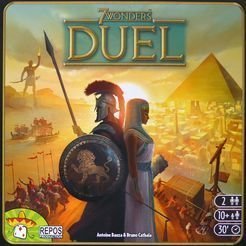
7 Wonders Duel
Tabletop Game
One of the most celebrated games in the world can now be experienced in a two-player arena. 7...
BoardGames 2PlayerGames

Interior Design Materials and Specifications
Book
This complete guide to the selection of materials for interiors has been updated to reflect recent...

Lanterns: The Harvest Festival
Tabletop Game
The harvest is in, and the artisans are hard at work preparing for the upcoming festival. Decorate...
2015Boardgames
Heather Cranmer (2721 KP) created a post
Oct 19, 2021
Purple Phoenix Games (2266 KP) rated Reef in Tabletop Games
Aug 1, 2019
Ahh ze coral reef. How beauteous is her expanse, and so nurturing for her oceanic inhabitants. We must endeavor to protect her and rebuild her as best we can to foster wildlife and entreat Mother Nature. We shall do this by selecting only the best coral combinations to satisfy the dying environment.
Reef is an abstract hand management, pattern building game that challenges the players to become coral reef architects and rebuild our fragile underwater ecosystem. This is a lofty goal, as our coral reefs in the real world are hurting for rejuvenation something fierce.
DISCLAIMER: I do not intend to cover every single rule included in the rule book, but will describe the overall game flow and major rule set so that our readers may get a sense of how the game plays. For more in depth rules, you may purchase a copy from the publisher directly or from your FLGS. -T
Setup is easy: shuffle the player mats and deal one to each player. The player that received the one board containing the starfish will be the starting player. Deal the players one of each colored coral piece, two cards from the deck, and 3 VP tokens. Place your reef chunks in the middle of your board in any order and you are ready to play!
On your turn you can do one of two things: draw a card or play a card. There are three cards face up to form the offer row, or a player can pay a VP token to the card with the lowest printed VP total to take the face up card on top of the draw pile (a la Small World). When you play a card, you immediately take the coral pieces on the card and place them on your play mat. The pieces can be stacked on other pieces of the same or different color, or on a blank spot on the mat. Once done, you check the card you played for any scoring conditions you may have met from your play mat. I will not go into detail about scoring, but there are several types of scoring that are employed in a game of Reef. The game continues in this manner until all of one color of coral pieces are used up. Players finish the round and then count their VP tokens. The winner is the player with the most VPs.
Components. The box is, what, normal sized? And the art on it is wonderful. So colorful and instantly recognizable. In fact, the art on the game in its entirety is truly amazing. I love it! The cards are of fine quality, but since they are handled a bit I sleeved mine. The VP tokens are of good quality, and I like that the pieces aren’t just perfect circles. It’s not a huge deal, but it helps with immersion just that much more. Same for the player mats. They could have been just as effective with square mats, but just that bit of wave makes it more enjoyable to play on for me. The big chunky coral pieces are so fun to play with, and handle, and, honestly, drop. They are very satisfying and great for those with colorblindness since they are all different shapes for the different colors they represent. All in all, Next Move Games knocks it out of the park on components AGAIN!
As you can tell by our score, we really like this game a lot. The first time I played it, my father-in-law used an interesting strategy and won the game. The next time I played it, I tried to use that same strategy and came in 3rd place. So, I chalked that win up to luck of the (card) draw and am now seeking more varied strategies to become the King of Reef. This is perhaps what also keeps the game from being a Golden Feather Award winner – I can play my game strategy and you can play yours, but that’s it. There is no real player interaction. As one Duke of Dice Alex would sing it, Reef is actually just “multiplayer solitaire.” While that is completely appropriate and non-offensive, I believe that with some more player interaction I would be more apt to bump this one to a 6. That said, we at Purple Phoenix Games give Reef a well-deserved bubbly score of 15 / 18. Emerson has himself another hit and I am proud to have it in my collection. You should grab it too, maybe.
Reef is an abstract hand management, pattern building game that challenges the players to become coral reef architects and rebuild our fragile underwater ecosystem. This is a lofty goal, as our coral reefs in the real world are hurting for rejuvenation something fierce.
DISCLAIMER: I do not intend to cover every single rule included in the rule book, but will describe the overall game flow and major rule set so that our readers may get a sense of how the game plays. For more in depth rules, you may purchase a copy from the publisher directly or from your FLGS. -T
Setup is easy: shuffle the player mats and deal one to each player. The player that received the one board containing the starfish will be the starting player. Deal the players one of each colored coral piece, two cards from the deck, and 3 VP tokens. Place your reef chunks in the middle of your board in any order and you are ready to play!
On your turn you can do one of two things: draw a card or play a card. There are three cards face up to form the offer row, or a player can pay a VP token to the card with the lowest printed VP total to take the face up card on top of the draw pile (a la Small World). When you play a card, you immediately take the coral pieces on the card and place them on your play mat. The pieces can be stacked on other pieces of the same or different color, or on a blank spot on the mat. Once done, you check the card you played for any scoring conditions you may have met from your play mat. I will not go into detail about scoring, but there are several types of scoring that are employed in a game of Reef. The game continues in this manner until all of one color of coral pieces are used up. Players finish the round and then count their VP tokens. The winner is the player with the most VPs.
Components. The box is, what, normal sized? And the art on it is wonderful. So colorful and instantly recognizable. In fact, the art on the game in its entirety is truly amazing. I love it! The cards are of fine quality, but since they are handled a bit I sleeved mine. The VP tokens are of good quality, and I like that the pieces aren’t just perfect circles. It’s not a huge deal, but it helps with immersion just that much more. Same for the player mats. They could have been just as effective with square mats, but just that bit of wave makes it more enjoyable to play on for me. The big chunky coral pieces are so fun to play with, and handle, and, honestly, drop. They are very satisfying and great for those with colorblindness since they are all different shapes for the different colors they represent. All in all, Next Move Games knocks it out of the park on components AGAIN!
As you can tell by our score, we really like this game a lot. The first time I played it, my father-in-law used an interesting strategy and won the game. The next time I played it, I tried to use that same strategy and came in 3rd place. So, I chalked that win up to luck of the (card) draw and am now seeking more varied strategies to become the King of Reef. This is perhaps what also keeps the game from being a Golden Feather Award winner – I can play my game strategy and you can play yours, but that’s it. There is no real player interaction. As one Duke of Dice Alex would sing it, Reef is actually just “multiplayer solitaire.” While that is completely appropriate and non-offensive, I believe that with some more player interaction I would be more apt to bump this one to a 6. That said, we at Purple Phoenix Games give Reef a well-deserved bubbly score of 15 / 18. Emerson has himself another hit and I am proud to have it in my collection. You should grab it too, maybe.
